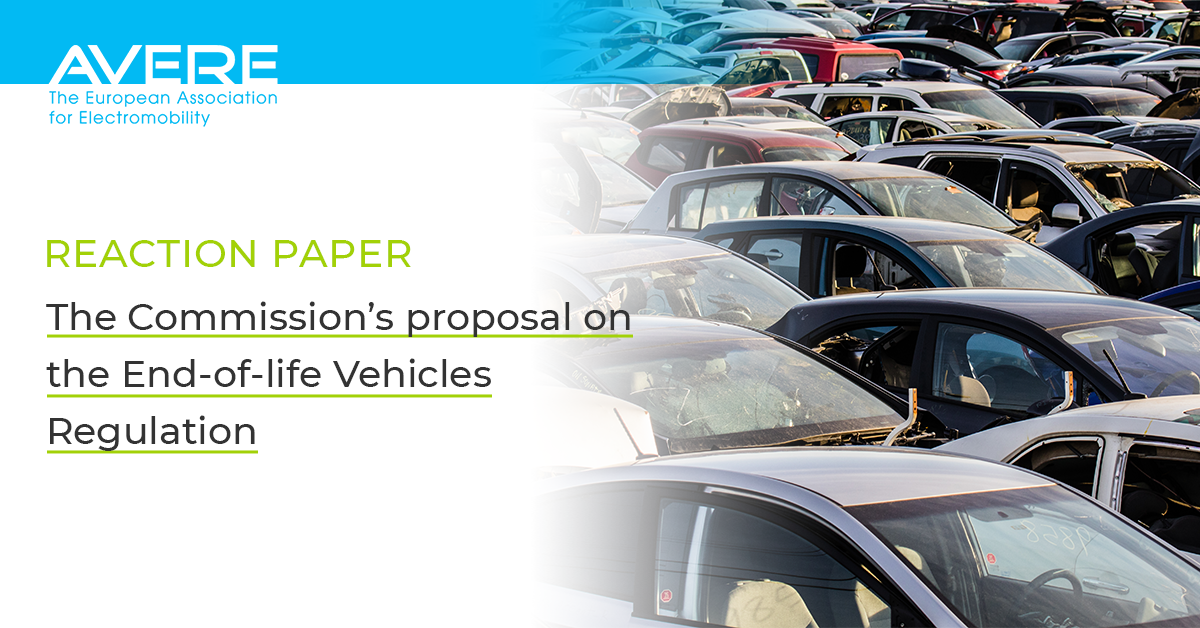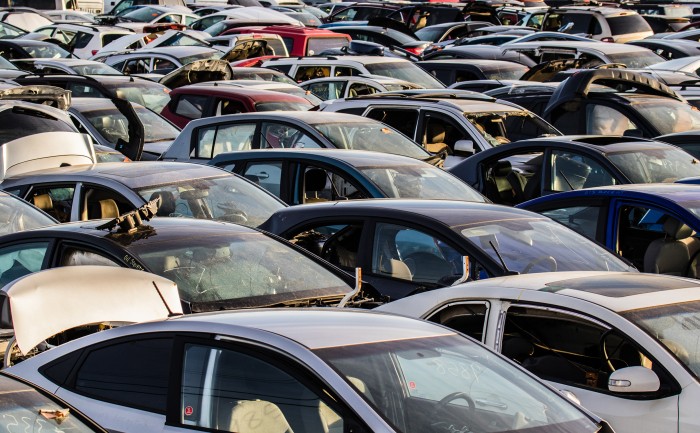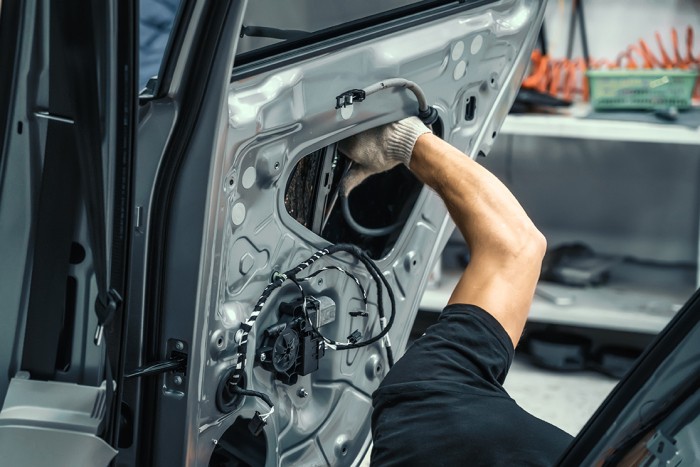
AVERE welcomes the European Commission’s proposal to revise Directive 2000/53/EC on end-of-life vehicles and Directive 2005/64/EC on the type-approval of motor vehicles with regard to their reusability, recyclability and recoverability and to transform it into a Regulation. This new Regulation will be a critical lever to continue improving the circularity and sustainability of future vehicles.
REACTION PAPER
The Commission’s proposal on the End-of-life Vehicles Regulation

AVERE welcomes the European Commission’s proposal to revise Directive 2000/53/EC on end-of-life vehicles and Directive 2005/64/EC on the type-approval of motor vehicles with regard to their reusability, recyclability and recoverability and to transform it into a Regulation. This new Regulation will be a critical lever to continue improving the circularity and sustainability of future vehicles.
Overall, AVERE believes that this Regulation rightly focuses on optimising the way vehicles are handled at the end of their useful life. This includes helpful specifications around Extended Producer Responsibility requirements, clearer roles and responsibilities along the End-Of-Life vehicle value chain, as well as more detailed information and labelling obligations to increase material recovery. The proposal also includes provisions concerning removability and recycled content targets which, if not properly designed and impact-assessed, might set unnecessary and counterproductive limitations on vehicle design.
Our members are committed to policies that incentivise the production and management of more circular, resource-efficient, high-performing and long-lasting vehicles with continuous improvements in material efficiency and carbon footprint. However, a sound transition to circularity requires time and investment as, in order to enable the electric vehicle industry to meet its material content targets, we need a dynamic value chain capable of supplying the necessary circular and carbon-neutral components.
Therefore, as the European Parliament and the Council are about to assess the Commission’s proposal, we call on the co-legislators to consider the following recommendations:
1. Ensure that vehicle design requirements for removability are not too prescriptive
AVERE is concerned about the proposal to guarantee design requirements for the removability of certain components and in particular batteries. While our members understand that battery removability is essential to ensure effective battery end-of-life treatment in line with the Battery Regulation, we believe that it should be left to manufacturers to make design choices that meet battery removability objectives. Setting prescriptive requirements that impact on vehicle design would discourage innovation and potentially contradict the objectives of safety and material efficiency.
Electric vehicles manufacturers are continuously innovating to ensure their vehicles, and especially their batteries, are safe. To this end, battery packs include a “housing”, which is a rigid enclosure protecting the battery from environmental factors such as water, dust, and salt. It also helps maintain a precise temperature and electrical insulation in the battery, and it prevents damages like rust and slow shorts. This housing element is essential to maintain the battery safe and avoid any hazard (thermal runaways, etc.). In this context, standardising components or component structure, assembly or disassembly steps, will lead to trade-offs, e.g in weight or safety, and ultimately limit optimal product design.
We therefore call on lawmakers to take safety aspects into account and avoid setting obligations that would have a negative impact on design freedom while supporting Authorised Treatment Facilities in removing and properly treating these parts. Additionally, we suggest improving the collaboration between OEMs and Authorised Treatment Facilities to ensure that these stakeholders are better equipped and trained to safely remove batteries and treat them, while maintaining battery safety throughout the vehicle lifetime.
Recommendations:
- Ensure that battery removability requirements do not impose prescriptive design requirements on OEMs
- Battery removability requirements should only be acceptable at the battery pack level, and if performed by certified and trained operators
2. Maintain the proposed Extended Producer Responsibility requirements
AVERE supports the proposed Extended Producer Responsibility requirements, which we evaluate as well-balanced and aligned with the principles established in the adopted EU Batteries Regulation.

To assist Authorised Treatment Facilities (ATFs) in their management of end-of-life vehicles, we support leveraging and improving existing information sharing systems, such as IDIS[1] (International Dismantling Information System) and IMDS[2] (International Material Data System) in order to help ATFs obtain more information with regards to dismantling and best treatment practices. These information systems help ATFs in their data management operations, as they have already proven their effectiveness and have been widely approved and used by the majority of OEMs, who would face a lighter administrative burden to comply with this Regulation while helping ATFs streamline their processes and make the business more cost-effective. A continuous improvement on the data quantity and quality under such systems would provide more transparency and better interconnectedness between affected stakeholders, thus optimising costs and environmental objectives for ATFs. Moreover, cost allocation between ATFs and manufacturers should remain fair and not be borne solely by vehicle manufacturers, as well as become objectively traceable through these information sharing systems.
AVERE further believes that all EPR reporting requirements relevant to vehicles should be centralised through a new EU-wide vehicle EPR scheme to simplify and accelerate EPR reporting procedures. This could involve setting up an EU one-stop-shop for EPR reporting at vehicle level, which includes all other EPR obligations for components and materials contained in vehicles (e.g. battery, tires, electronics, textile, etc). This information could be centralised and stored in a “vehicle passport” which refers to the battery passport via one single QR code.
EU policy-makers should also focus on harmonising requirements across the related legislations. The Regulation on end-of-life vehicles works in concert with other circularity-related legislation, such as the Directive on waste electrical and electronic equipment (WEEE Directive) and the Directive on packaging and packaging waste. These legislations also specify financial responsibilities for producers as part of their Extended Producer Responsibility, and the objectives of these laws may overlap. Where possible, the Regulation on end-of-life vehicles should thus help create a mechanism for financial redistribution between related EPR compliance systems where possible.
Furthermore, the legislation should provide more clarity on the possibility for vehicle manufacturers to choose between individual and collective EPR systems. We also believe that the Regulation should set clearer provisions concerning quality obligations for dismantling and shredding processes and outcomes.
Recommendations:
- Centralise all EPR reporting relevant to vehicles in a new EU-wide vehicle EPR scheme.
- Consider setting up a financial redistribution mechanism between other EPR compliance schemes wherever possible (e.g. WEEE Directive, Directive on packaging and packaging waste).
- Maintain the existing cost allocation system as they currently operate at national level, where applicable.
- Rely and continuously improve existing information sharing systems, such as IDIS and IMDS, to help ATFs in their data management operations and let them obtain more information with regards to dismantling and best treatment practices.
- Keep the possibility, and provide more clarity in the Regulation, to choose between individual and collective EPR schemes.
- Additionally, there should be a more stringent and accurate quality obligation for dismantling/shredding processes and outcomes.
3. Harmonise passport and labelling requirements with the Battery Regulation
AVERE acknowledges the new requirements to create a circular vehicle passport which would contain information on removal and replacement of parts, components and materials present in vehicles. We believe that this tool would considerably help Authorised Treatment Facilities and other stakeholders involved in the end-of-life of vehicles to obtain the necessary information to dismantle vehicles and batteries, and it would also help optimise their practices and cost management accordingly.
We urge lawmakers to grant car manufacturers the option to harmonise passport and labelling requirements with those of the adopted EU Batteries Regulation to avoid any duplication. This would mean having an all-in-one passport, bundling EU Batteries Regulation and End-of-Life Vehicles Regulation requirements, which could be leveraged as one-stop shop for passport holders and Authorised Treatment Facilities. The requirement should stay flexible to allow manufacturers who can merge both passports and QR codes to do so, while taking into account vehicles with replaceable batteries and the overall modularity of certain vehicles. Indeed, while it may be easier for some manufacturers to merge labelling requirements, it may prove to be challenging for others. The framework should therefore work in both cases, allowing manufacturers to choose what works best for their vehicles’ design.

Recommendations:
- Allow OEMs to turn the proposed vehicle passport into an all-in-one passport that would refer to the vehicle’s battery passport already required under the adopted EU Batteries Regulation via one QR code.
- Avoid any inconsistencies or duplications in information sharing and reporting requirements from other sectoral legislation (EU Batteries Regulation, waste legislation etc).
4. Establish realistic recycled content targets based on clear methodologies
Our association recommends a more cautious approach on recycled content targets based on realistic market conditions and performance characteristics. While we encourage the uptake of recycled content in electric vehicles, we believe this content needs to be made available by the plastic, aluminium and steel industries before mandating car producers to include these components in their vehicles. As a result, we highly recommend to adopt appropriate methodologies and to carry out additional feasibility studies before mandating any recycled content targets.
Indeed, the current proposal lacks the definitions, methodologies and reference data needed to make informed decisions on the target the EU should set. By way of example, the current definition of "plastics" needs to be improved, as it currently refers to that used in REACH and is linked to the Ecodesign for Sustainable Products Regulation, although the automotive sector is excluded from its scope.
With regards to recycled plastics content targets, we suggest maintaining a careful approach and ensuring these targets can be met based on material availability and commercial scale. As such, we suggest delaying these targets to 2035 in order to ensure the European plastic value chain is ready to meet these objectives. Furthermore, to meet safety and durability objectives, many of the plastics used in the automotive industry are high-performance products, which require the highest quality of polymers available, and which can be very difficult to recycle. To this extent, suppliers should be obliged to provide information on the types of polymers contained in their plastics and whether they used recycled content or not. It will be also important to clarify in the methodology whether plastics will be considered at the component or at the semi-component level.

Additionally, AVERE would like to emphasise that post-consumer plastic waste is often contaminated and degraded, and this could lead to a very small supply of appropriate recycled material to achieve the required target. Given the diversity of materials used in modern cars, including carbon fibre-reinforced plastics, it is important to conduct further feasibility studies before setting ambitious recycling targets and timelines. For example, carbon fibre, which is difficult to recycle and can contaminate waste streams, can reduce carbon footprint and energy consumption.
We would also like to emphasise that positive effects in 3R (Recyclability, Reusability, Recoverability) and ELV (End-of- Life Vehicles) can be better achieved with a gradual phase-in of stricter quotas and a gradual shift to a circular economy. Imposing such requirements from a single fixed cut-off date would massively damage the lifecycle and the investment cycle. Considering the modular vehicle strategy of several manufacturers, target recycled content should not apply to new models of cars based on old vehicle platforms, as this would lead to the obsolescence of complete vehicle architectures.
Finally, in light of the review of this legislation, we invite the Commission to evaluate the cleanest recycling technologies available and refer to them in the future.
Recommendations:
- Clarify the baseline, definition and methodology to measure the proposed recycled plastic content targets
- Amend the scope of the recycled plastic content targets to include pre-consumer and post-consumer waste.
- Suggest a later deadline to meet the proposed recycled plastics target in order to avoid increasing secondary material import dependency from third countries.
- Review the 25% recycled plastics target based on material availability.
- Apply minimum recycled content targets only on future vehicle platforms so that OEMs can ensure that existing platforms reach their full life cycles or full useful lives.
- Support the setting of recycled content for steel and aluminium for a later stage and based on a detailed impact assessment as well as clear baselines, definitions and methodologies to measure the targets
- Consider evaluating the cleanest recycling technologies available and refer to them when reviewing this legislation.
